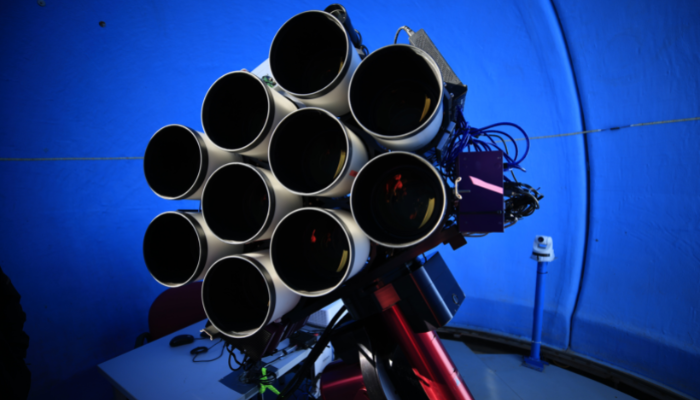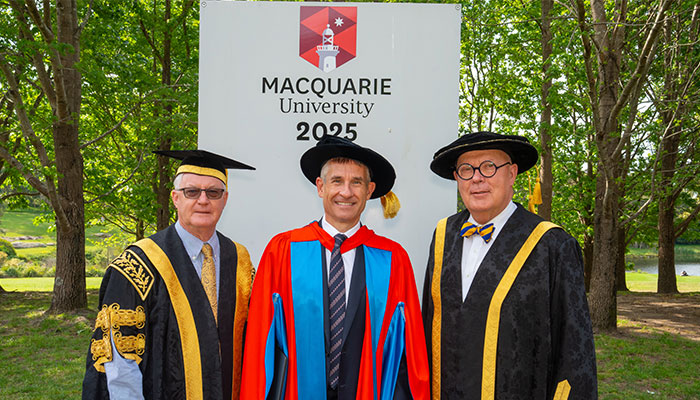Macquarie University supported by Canon Australia today officially unveils The Huntsman Telescope – a novel telescope concept designed to ‘hunt’ for and study ultra-faint galaxies and astronomical objects in the Southern Sky. Comprising an array of 10 commercially available Canon EF 400mm f/2.8 L IS II super-telephoto lenses, the Huntsman Telescope is the only telescope of its kind in the Southern Hemisphere.
 Located at the Siding Spring Observatory near Coonabarabran, NSW, the Huntsman Telescope will perform deep southern sky surveys to provide researchers with a unique understanding about galaxy formation and evolution; how galaxies form, how they grow, how they engage with structures that surround them, and what happens when galaxies collide.
Located at the Siding Spring Observatory near Coonabarabran, NSW, the Huntsman Telescope will perform deep southern sky surveys to provide researchers with a unique understanding about galaxy formation and evolution; how galaxies form, how they grow, how they engage with structures that surround them, and what happens when galaxies collide.
According to Principal Investigator of the Huntsman Telescope, Dr Lee Spitler, from Macquarie University’s School of Mathematical & Physical Sciences and Australian Astronomical Optics-Macquarie, the Huntsman Telescope’s work will be crucial to understanding what might happen should our Milky Way Galaxy have a head-on collision with its neighbour, the Andromeda Galaxy – an event theorised to occur in 4.5 billion years.
“The Huntsman Telescope is pioneering the way in which we view our Southern skies by capturing images of the faintest galaxy structures that conventional telescopes simply couldn’t,” says Dr Spitler. “The ability to observe the remnants of galaxies colliding with each other and searching for the faintest and smallest galaxies in the universe, will help us understand the potential fate of the Milky Way in the far distant future.”
Inspired by the innovative Dragonfly Telephoto Array, based in the United States, the Huntsman Telescope comprises Canon EF 400mm f/2.8 L IS II super-telephoto lenses which are usually used by professional sports or wildlife photographers.
Part of Canon’s L-series professional lens range, the second-generation Canon EF 400mm f/2.8 L lens has superb anti-reflection properties, owing to one of the first applications of Canon’s patented nano-fabricated coatings with sub-wavelength structures on optical glasses. The coated lens array contrasts to a conventional mirror telescope, whose imperfectly polished surface can introduce subtle errors that ruin faint, extended structures surrounding galaxies.
Furthermore, each lens in the array is equipped with a single monolithic wide-field detector covering six square degrees. With multiple redundant lines of sight, the Huntsman is able to achieve extremely accurate modelling of the night sky emission and produce ultra-clear renderings of our universe.
“For 80 years, Canon has been committed to developing precision optical technologies that exceed the needs of our customers, and we’re proud that our EF-lenses will play a role in helping Australian scientists tackle some of the most critical questions in astronomy today,” said Kotaro Fukushima, Managing Director, Canon Oceania.
“With our origins in camera development, Canon has diversified its business and technological potential to become essential to a wide range of fields - from space exploration to printing, medical equipment and security - with the purpose of solving diverse social challenges and enriching the lives of all global citizens. In combining our innovative imaging technology with AI, cloud, and other IT solutions, Canon is helping to unlock the next stage of the future.”

The Orion Nebula through the Huntsman Telescope. CREDIT Sarah Caddy, PhD Candidate
Of the nine members of the Huntsman Telescope’s technical and science team, five are Macquarie University PhD students, who are benefiting from the unique opportunity to have hands-on training with such high-tech equipment.
According to Sarah Caddy, PhD Candidate from the School of Mathematical and Physical Sciences at Macquarie University, in observing the Dragonfly Array program in the Northern Skies, the approach of combining individual EF 400mm f/2.8 L IS II super-telephoto lenses will enable the Huntsman telescope to scale with the needs of scientists in the future. Recent upgrades to the telescope are already set to further enhance Huntsman’s abilities in studying the Universe.
“The Huntsman’s new suite of powerful computers enable each lens or ‘eye’ of the Huntsman to operate independently of each other. This will allow the telescope to autonomously detect ultra-fast transient events like stellar flares from distant stars, or even more exotic phenomenon like aiding the search for origin of fast radio bursts that continue to elude astronomers,” says Ms Caddy.
The Huntsman Telescope project is a jointly-led project from Macquarie University School of Mathematical and Physical Sciences and the Australian Astronomical Optics-Macquarie, both within the Faculty of Science and Engineering at Macquarie University. The project is supported financially by a Discovery Project awarded through the Australian Research Council.
The Huntsman Telescope will be open to the public on 1 October 2022, as part of the annual StarFest.
For more information on the Huntsman Telescope, please visit the Macquarie University website here.
For more information on the Canon EF 400mm f/2.8 L IS II super-telephoto lenses, please visit the Canon Australia website here.



